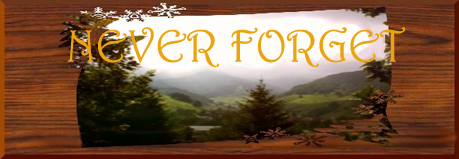------------------------------------------------------------------------------
Recently among the dragonkin community I have seen a certain prejudice being placed on those dragonkin who associate with a more western dragon and yet seem to appear as more of a winged canine or feline; instead of the reptilian form that we have come to accept as the only model for a western dragon.
If you look at most dragon kin’s self-portraits it also supports this prejudice as it seems that most eastern dragonkin will allow themselves a more feline or canine appearance yet most western dragonkin feel confined to, and indeed automatically influenced by, the reptilian form of dragon. A form that has also become popular in our modern dragon art. For some reason we seem to have accepted that western dragons MUST be reptilian.
-----------------------------------------------------------------------------------
E.g.
Some popular models for dragon art-
---------------------------------------------------------------------------------
Eastern dragons-


Artwork done by Hibbary http://hibbary.deviantart.com/
------------------------------------------------------------------------------------
Western Dragons-

Artwork by PhantomSeptember http://phantomseptember.deviantart.com/ ... n-59325189

Artwork by RedQueen2112 http://redqueen2112.deviantart.com/art/Dragon-14649520
----------------------------------------------------------------------------------
Knowing these models to be consensually true, it seems unlikely that such a strong model of appearance would not influence newly awakening dragonkin and they view their draconic appearances. When awakening it’s best not to be too influenced by popular forms of belief around you, so having such a strong black & white view of draconic appearance is a dilemma that goes against one of the primary bases of awakening.
So I’m here to say that it’s okay to have a more canine/feline form combined with a western body-type! Why am I saying this? Because the formation of the reptilian western is very much a construct of our modern times, and in the past western dragons were very diverse and, it is fair to say, considerably less driven to the reptilian.
------------------------------------------------------------------------------------------
Observe-

What we see here is an egg tempura from 1260 titled “The Virgin and Child Enthrones, With Narrative Scenes” by Magarito of Arezzo. The picture is compliments of the National Gallery, London; where this piece is held, and where most of my examples will come from. But, wait, what is that in the bottom right corner? Could it be?

Yup- It’s a western dragon.
The aim of Altar pieces such as this one was, of course, to avoid rendering reality, yet we still can see a notably canine form; the paws are distinctly dog-like, as is the muzzle, ears and nose. Yet this is still a western dragon, suffice to say that this gives a perfect example of how the “western dragon” model we know today is exactly that; a model of today’s society, a construct of the criteria people associate dragons with, more than likely influenced by more modern texts on the dragons appearance and the gradual evolution of art that we see developing throughout all subjects.
---------------------------------------------------------------------------------
Let’s look at some more examples shall we?
Skipping to one of my favourite Vasari pen-portraits, here are some dragons by one of our favourite renaissance artists in the cannon; Leonardo da Vinci.

Fight between a Dragon and a Lion (c. Leonardo’s lifetime, what!?! He didn’t date his doodles!) puts feline and western dragon side-by-side to call into detail the similarities between the two beasts that were recognised in his time. Not only does the western dragon have thick fur instead of scales, which we commonly link with the western dragon, but when looking in close detail-

We can see the same whiskers, feline-like ears and a similar flow of fur indicating a mane of sorts. The feet of the dragon are also almost identical to the lion’s paw. If any more proof is needed for the link between feline and western dragon in times past then here is another sketch by Leonardo-

In this study of cats by Leonardo we can see one solitary western dragon (wingless) lurking in the midst; bringing directly to our attention to feline past of the western dragon.
-------------------------------------------------------------------------
Although this following picture beckons the coming of the reptilian dragon, it would be irresponsible of me to leave out this iconic piece of draconic art.
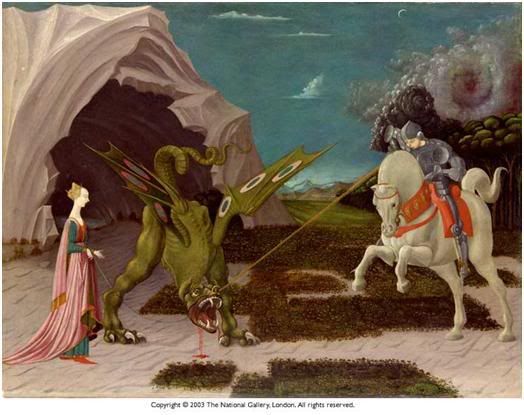
Saint George and the Dragon, done by Uccello circa 1470, is very important in our understanding of the dragon throughout art (Saint George is also, unfortunately for me, a British icon). Maybe this is why we have deviated into the reptilian form of a western dragon, working from this piece onwards. Yet, even a western dragon like this is not truly reptilian. We still note the distinctly mammalian hind legs and feet, as well as a canine-like snout and ears. Beyond that the wings are decorated with patterns similar to a butterfly! Diverse, ‘eye?
----------------------------------------------------------------------------
Just a quick one next (because one of my favourites is coming up in a sec)
The Virgin and Child with an Angel, by Hanz Memling circa 1480.
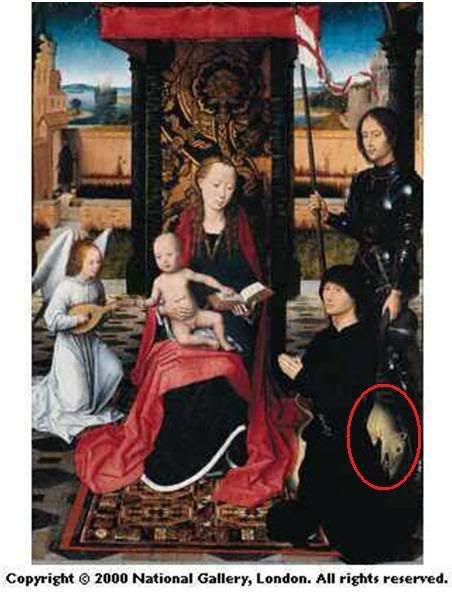
Believe it or not that’s a western dragon, not a rat.
--------------------------------------------------------------------------
Now, one of my personal favourites! Two Followers of Cadmus Being Devoured by a Dragon, by Cornelis van Haarlem in 1588. –glomps-

Note the snout and ears, the distinctly non-reptilian jaws and claws; it’s almost like seeing a lion rip into its prey. There are even whiskers! Even more noticeable is the fact that there is obviously more emphasis on realism in this painting and yet the dragon has no scales- it is smooth and shiny. I love this piece of art work; this and the egg tempura really represent for me the diversity of the western dragon.
---------------------------------------------------------------------------
Saint George Killing the Dragon, circa 1610 by Domenichino-

Now we’re seeing a more reptilian form the we associate to the western dragon, but the key my friends is in the detail-
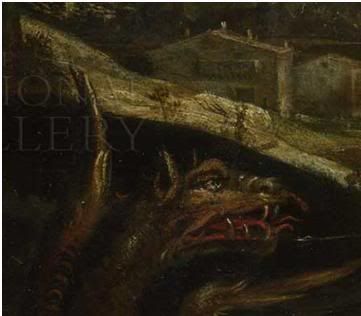
With the ears, muzzle and jaw we can still see a canine influence prevailing over a reptilian influence. The facial structure is also more akin to a canine that a reptile and the eyes are not reptilian in the slightest.
-----------------------------------------------------------------------------
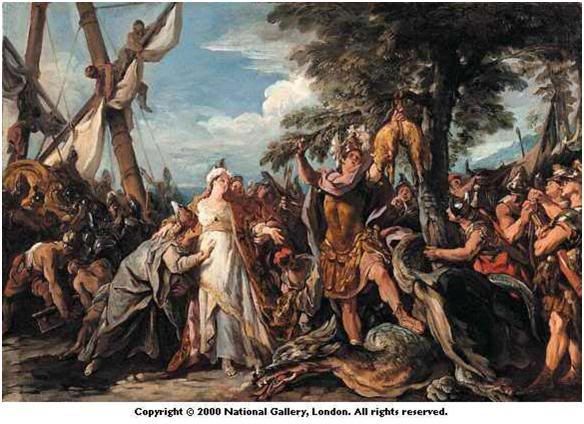
So here we are; The Capture of the Golden Fleece, Jean-François Detroy done in 1742-3. While the scales are still lacking and the claws are not distinctly non-reptilian, we can see the forked tongue is in full effect, there is emphasis on single front-fangs and the muzzle has become more slender and crocodile-like. So I guess this is the era of the reptilian western......

........
I guess not.
Saint George and the Dragon, by Gustav Moreau, 1889-90.
Correct my original statement; western can now include not only canine and feline orientation, but avians as well (and come to think of it you can add in butterfly as well). This may look more like a griffin but it is, in fact a western dragon. They have a tendency to surprise you don’t they?
---------------------------------------------------------------------------
By now I’m hoping it’s hit home that-
-For all those out there who complain about the more canine-looking dragons; this is natural and, part of our history of the concept of the dragon, not something to be ridiculed, dismissed, discouraged or instantly indicative of a poser.
-For all those newly awakening western dragon kin, who are just starting to experiment with their phantom form or past life memories; a lack of scales does not equal fail.
So please, embrace the western diversity; there are worst things out there than breaking the stereotype.
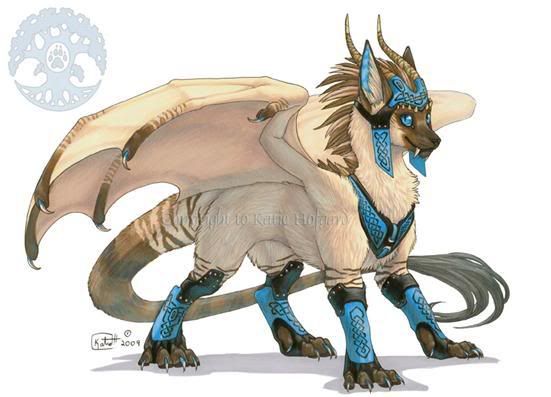
Artwork by Shadow-wolf http://shadow-wolf.deviantart.com/art/K ... -108349623
FIN.




